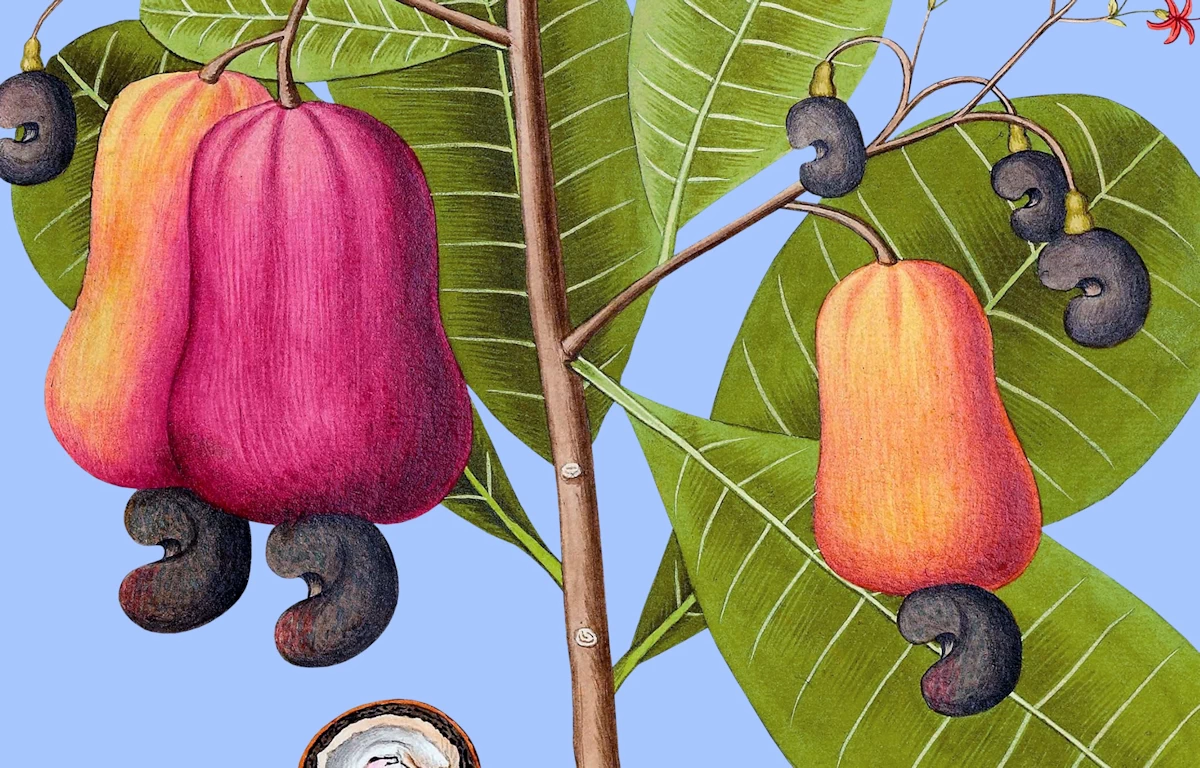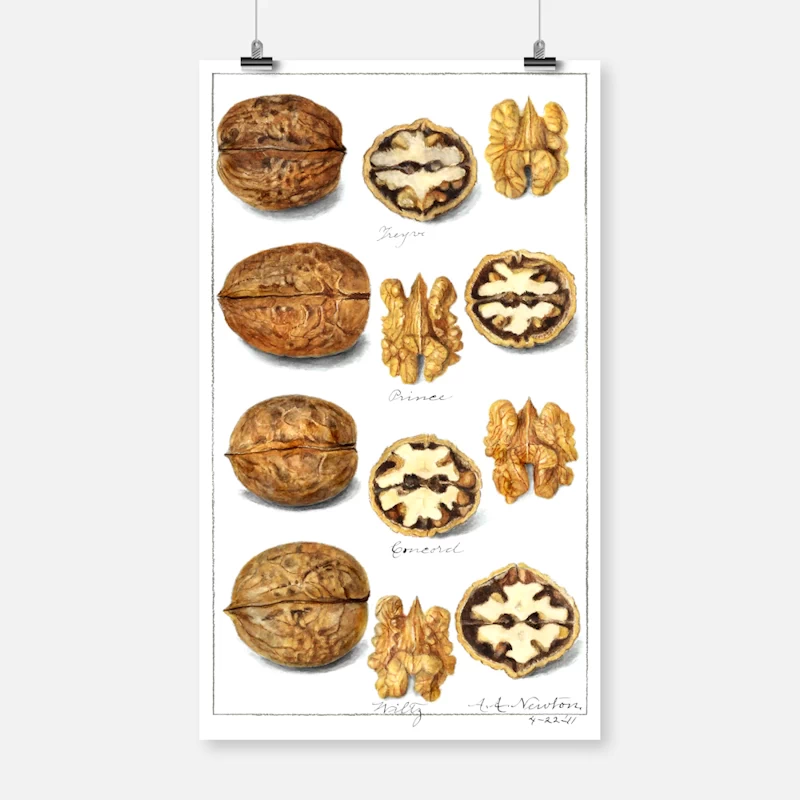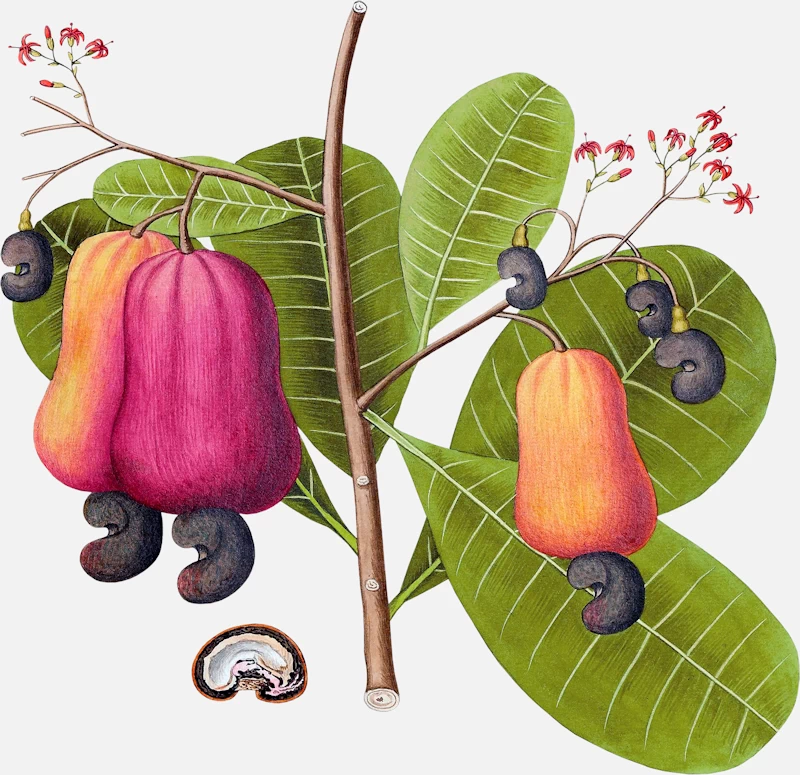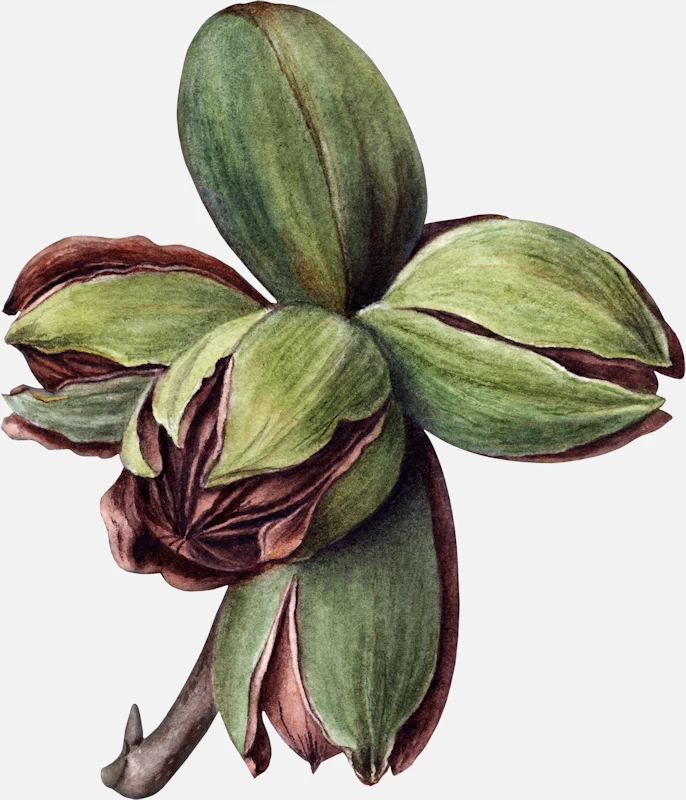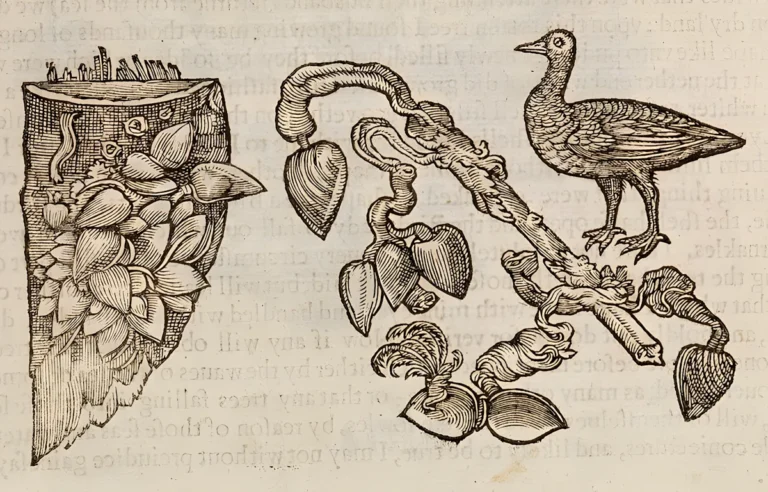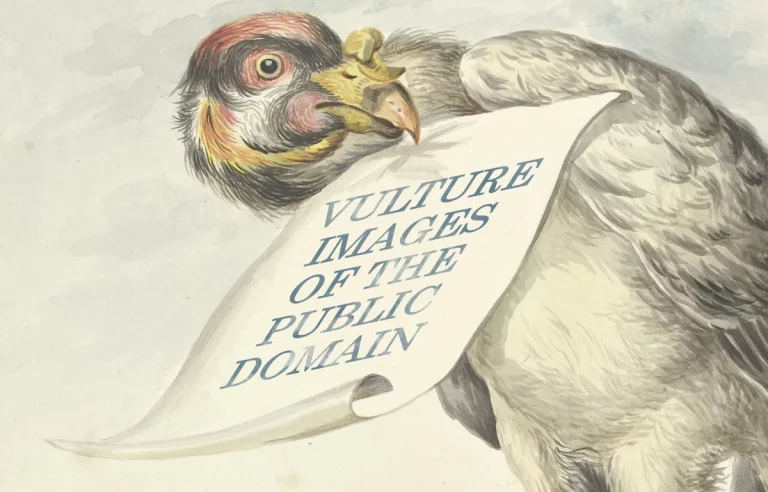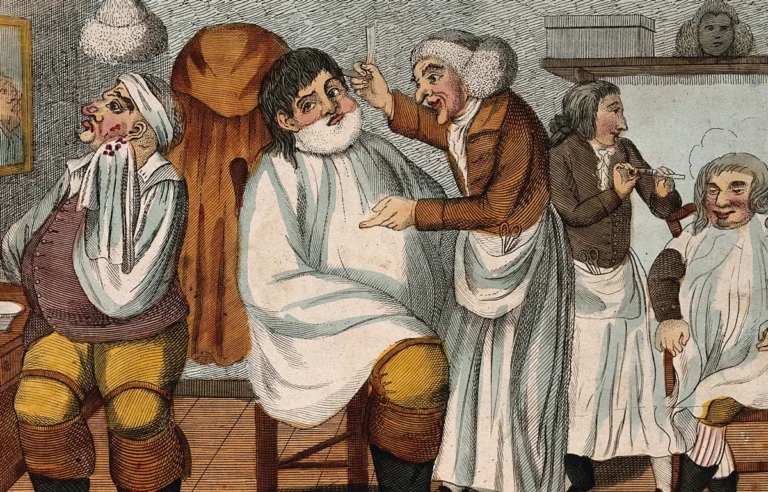The Nutty History of Nut Illustrations: A Delightful Journey Through Time
Welcome to the crunchy, crackly world of nut illustrations! It might sound a bit nuts, but these charming artworks have a rich history and reveal a lot about our fascination with these tasty treats. We’re going to crack open the stories behind some classic nut illustrations, focusing on walnuts, cashews, hazelnuts, chestnuts, almonds, and pecans. So grab a snack, settle in, and let’s take a fun-filled tour through the nutty world of art!
Walnuts: A Regal Treat
Our journey starts with the walnut, a nut with a history as rich as its flavor. Walnuts have been admired for centuries, not only for their taste but also for their distinctive, brain-like appearance. This unique shape caught the eye of many artists, one of whom was Amanda Almira Newton. In 1911, Newton created an exquisite illustration of walnuts that beautifully captured their intricate texture and natural beauty.
Newton’s illustration is a perfect example of how artists have long been fascinated by the walnut’s complex form. Her work was part of a broader trend in the early 20th century where botanical artists aimed to combine scientific accuracy with artistic flair. Newton’s walnut drawings don’t just show what the nut looks like; they also convey a sense of the walnut’s texture and the fine details of its shell.
The walnut’s rich history isn’t just about its appearance, though. This nut was a favorite among ancient civilizations, including the Greeks and Romans. They saw walnuts as symbols of wisdom and intellect because of their brain-like shape. Fast forward to the Renaissance, and walnuts were featured in detailed botanical illustrations, showing off their complex and regal nature.
Cashews: A Tropical Delight
Next up, let’s dive into the world of cashews, a nut that’s a bit of a tropical wonder. Cashews are unique because they grow from the bottom of a fruit called the cashew apple. This unusual growth pattern caught the attention of Nikolaus Joseph von Jacquin, who illustrated the cashew in 1780. His work is a fantastic example of how botanical illustrations from the 18th century combined scientific curiosity with artistic skill.
Jacquin’s drawing of the cashew not only shows the nut but also highlights its connection to the cashew apple. His illustrations were groundbreaking at the time, providing one of the earliest detailed looks at this exotic nut. Jacquin’s attention to detail helped botanists and explorers understand more about this tropical treat, making his work an important part of nut illustration history.
Cashews have a fascinating story beyond their appearance. Native to Brazil, they were an important food source for Indigenous peoples long before Europeans arrived. The nut became popular around the world, and its unique growing method and tropical origins made it a favorite subject for artists and botanists alike.
Hazelnuts: Nature’s Little Gems
Now let’s crack into the world of hazelnuts. These small, round nuts have been illustrated for centuries, and one standout artist is William Hooker, whose work from 1818 remains a benchmark in botanical art. Hooker’s hazelnut illustrations are renowned for their precision and detail, showcasing not just the nut but also the plant it grows on.
Hooker’s illustrations are a great example of the 19th-century botanical art trend, which focused on capturing nature’s smallest details. His work helped popularize the hazelnut, showing it not just as a tasty snack but as a fascinating part of the natural world. Hooker’s ability to blend scientific accuracy with artistic flair made his hazelnut drawings both educational and beautiful.
The hazelnut’s history is as rich as its flavor. This nut has been a part of human diets for thousands of years, with ancient civilizations using it in various dishes. Its popularity continued through the Middle Ages and into modern times, where it remains a beloved ingredient in sweets and snacks. Hazelnut illustrations often emphasize its charming, nutty appearance and its role in the history of food.
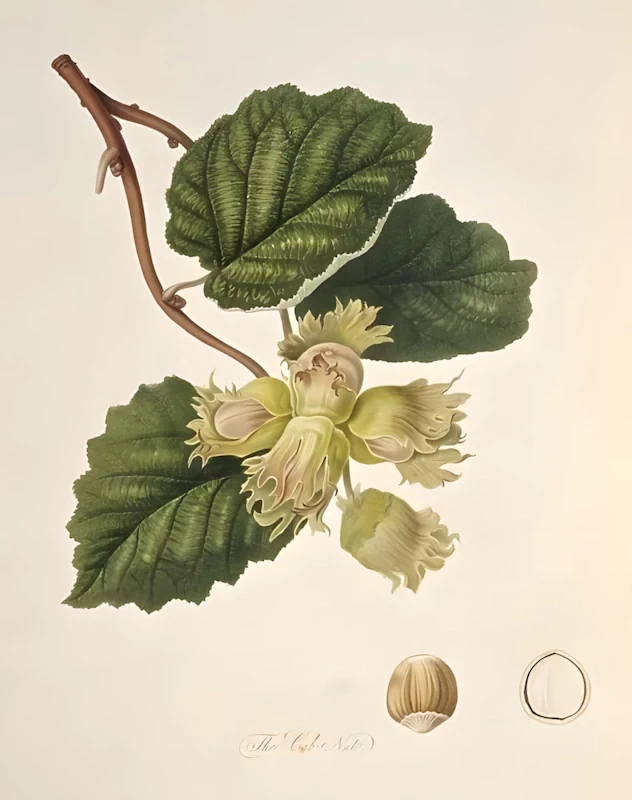
William Hooker (1818)
Chestnuts: A Nutty Tradition
Moving on, let’s explore the chestnut, a nut with a deep historical and cultural significance. The chestnut has been a staple food in many cultures, and one artist who captured its essence beautifully was Georgio Gallesio. His work from 1817 to 1839 includes stunning illustrations of chestnuts that highlight their unique shape and texture.
Gallesio’s chestnut illustrations are part of a broader trend in early 19th-century botanical art, which aimed to document and celebrate the diversity of plant life. His work shows not just the chestnut but also the tree it comes from, offering a comprehensive view of this important nut. Gallesio’s detailed drawings helped spread knowledge about chestnuts and their role in various cuisines.
Chestnuts have a long history as a food source, especially in Mediterranean countries. They were used in ancient Greece and Rome and became a staple in European diets during the Middle Ages. Today, chestnuts are enjoyed around the world, often roasted and eaten as a delicious snack. Gallesio’s illustrations remind us of the chestnut’s rich heritage and its continued importance in our diets.
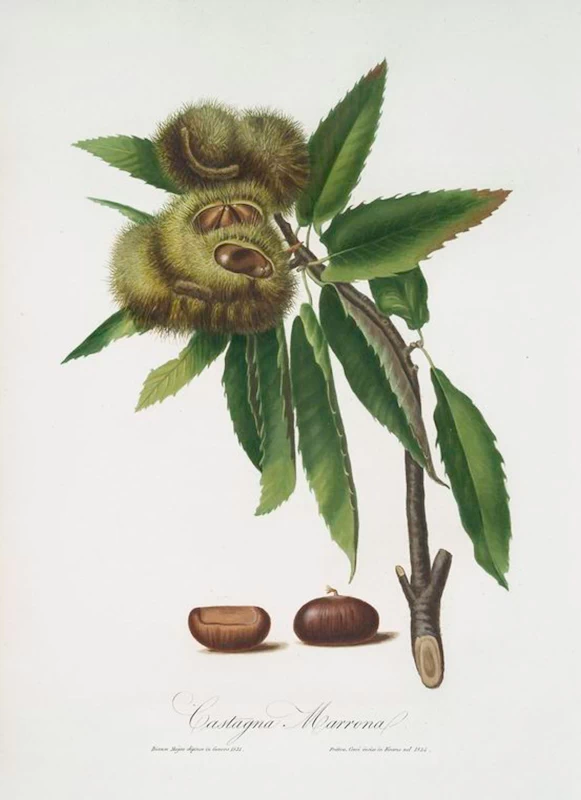
Giorgio Gallesio (1817-1839)
Almonds: A Nut with a Rich Legacy
Next up is the almond, a nut with a history that stretches from ancient civilizations to modern times. Otto Wilhelm Thomé’s illustrations from 1888 offer a detailed look at almonds, showcasing their distinctive shape and the beautiful flowers of the almond tree.
Thomé’s work is a prime example of 19th-century botanical art, which combined scientific accuracy with artistic elegance. His illustrations of almonds capture the nut’s delicate form and the tree it grows on, offering a comprehensive view of this important nut. Thomé’s attention to detail helped spread knowledge about almonds and their role in various cuisines and cultures.
Almonds have been cherished for their flavor and health benefits for thousands of years. Ancient Egyptians and Greeks used almonds in their cooking, and they continue to be a popular ingredient in many dishes today. Thomé’s illustrations highlight the almond’s long history and its ongoing significance in the culinary world.
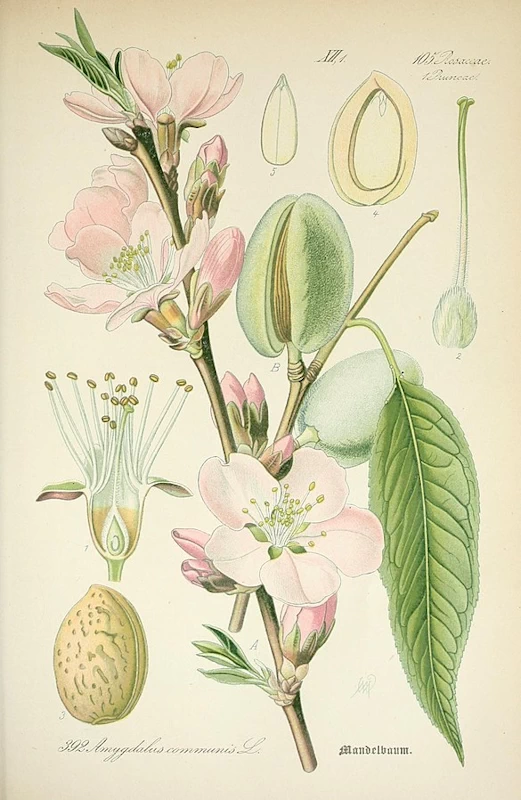
Otto Wilhelm Thomé (1888)
Pecans: A Southern Delight
Finally, let’s crack into the world of pecans, a nut with a special place in American cuisine. Deborah Griscom Passmore’s illustration of pecans from 1904 is a perfect example of how botanical art captured the beauty and detail of this nut.
Passmore’s work showcases the pecan’s unique shape, still inside its outer green shell. Her illustrations are part of a tradition of botanical art that aimed to document and celebrate the diversity of plant life. Passmore’s detailed drawings helped spread knowledge about pecans and their role in Southern cooking.
Pecans have a rich history in North America, where they were an important food source for Indigenous peoples. They became a popular ingredient in Southern cooking, especially in the form of pecan pie. Today, pecans are enjoyed around the world, and Passmore’s illustrations remind us of their delicious flavor and cultural significance.
A Nutty Legacy
From ancient civilizations to modern kitchens, nut illustrations have captured our fascination with these delightful treats. Artists like Amanda Almira Newton, Nikolaus Joseph von Jacquin, William Hooker, Georgio Gallesio, Otto Wilhelm Thomé, and Deborah Griscom Passmore have all contributed to our understanding and appreciation of nuts through their detailed and beautiful illustrations.
These artworks not only show us what nuts look like but also tell us about their history, cultural significance, and role in our diets. So next time you enjoy a walnut, cashew, hazelnut, chestnut, almond, or pecan, remember that you’re enjoying a little piece of history, beautifully captured by some talented artists.
Nuts may be small, but they have a big story to tell. And as we continue to explore and appreciate these delightful treats, we’ll undoubtedly find even more nutty stories to enjoy. So here’s to the nuts and the artists who have illustrated their delicious journey through time!


